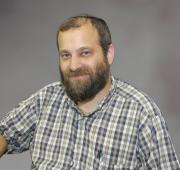תנועות עיניים ותפיסה ראייתית
Zivotofsky and his team apply engineering principles to biological questions, primarily in the field of vision and ocular motility.
Most people do not realize that their eyes make all sorts of movements many times a minute, and that there are numerous brain areas devoted to programming these movements. Usually it is only when a person cannot execute a desired movement, or is plagued by unwanted movements, that they give it any thought. In Zivotofsky’s lab, the team studies how various movements are planned and carried out in healthy individuals and what can go wrong in various diseases. This latter component is carried out in a lab at Meir Hospital. In Bar Ilan some of the recent studies have focused on double step saccades, anti-saccades, and the Stroop effect.
Together with a neurologist and a physicist, the team uses the only human magnetic search coil in the country to precisely record and study the eye movements of patients with a variety of diseases including Parkinson’s, stiff person syndrome, and Machado-Joseph disease. While ocular motility was the starting point, research in the lab has branched out to several related fields.
Together with an Israeli start-up they have been using the latest tools to study cognitive functioning in a variety of circumstances.
As part of a multidisciplinary, international team the lab has been studying PTSD and c-PTSD in survivors of ISIS captivity.
Access to schizophrenic patients has been provided via collaboration with Beer Yaakov mental facility and has enabled several studies pertaining to visual perception in schizophrenic individuals.
The study of vision and eye movements has led the lab to related fields. For example, a casual observer may fail to notice that a pair of walkers strolling together will often synchronize their gait. This previously unnoticed phenomenon was first reported by Zivotofsky’s lab in collaboration with a gait lab in Tel Aviv University. They initially hypothesized that visual feedback plays a role in the synchronization process, but ongoing research in their lab and in several other labs have found no evidence of this. Nor have they been able to explain what mechanism is used.
Understanding how healthy walkers unintentionally synchronize may aid in designing rehabilitation protocols for patients; this is an ongoing project in the lab.
In addition, the study of medical ethics, both in general and from a Jewish perspective, is a relatively new area of interest in the lab. Zivotofsky and his group are exploring issues related to abortion, beginning of life, end of life, medical education, and the care of terrorists.
תחומי מחקר
שיטות מחקר
תאריך עדכון אחרון : 31/03/2019




